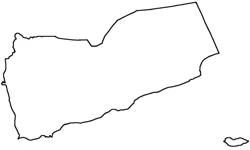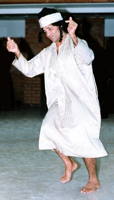
|
The Society of Folk Dance Historians (SFDH)
Yemenite Dancing
[
Home |
About |
Encyclopedia | CLICK AN IMAGE TO ENLARGE |

|
 Because of strict segregation imposed by their Arab neighbors and their geographic isolation from other Jewish communities, the Yemenite Jews maintained a unique culture, unlike that of other Middle Eastern Jewish groups. Aspects of their attire, language, dance, and melodies are thought to preserve ancient traditions that date back thousands of years.
Because of strict segregation imposed by their Arab neighbors and their geographic isolation from other Jewish communities, the Yemenite Jews maintained a unique culture, unlike that of other Middle Eastern Jewish groups. Aspects of their attire, language, dance, and melodies are thought to preserve ancient traditions that date back thousands of years.
How did this community of Jews come to settle in Yemen? It would seem probable that, after the destruction of the First Temple in Judea in 586 BCE, exiled Jews wandered along the "Spice Road," an important trade route that crossed the entire Arab Peninsula from modern day Eilat in Israel to Aden, Yemen.
In Yemen, wanderers found opportunities for establishing productive livelihoods. Gradually, with the rise of Islam, the Yemenite Jewish settlements were severed from tehir brethren cultures in Judea. Further legal restrictions in Yemen, which imposed cultural and physical separation between Moslems and Jews, helped to isolate Jewish traditions from surrounding influences.
 When the State of Israel was established in 1948, however, the flight of tens of thousands of emigrants ensued, culminating in the Operation Magic Carpet. This massive airlift, sponsored by the Israeli government, brought 55,000 new Yemenite immigrants to Israel for re-settlement. With them came a rich heritage of ancient dances, music, and folklore outstanding for its vitality and distinctive features. At the time of Operation Magic Carpet, the dance of the Yemenite Jews was a treasure of rare dance material that drew upon centuries of traditions. It was remarkable for its originality and the fact that it had remained untouched by Western influence for generations.
When the State of Israel was established in 1948, however, the flight of tens of thousands of emigrants ensued, culminating in the Operation Magic Carpet. This massive airlift, sponsored by the Israeli government, brought 55,000 new Yemenite immigrants to Israel for re-settlement. With them came a rich heritage of ancient dances, music, and folklore outstanding for its vitality and distinctive features. At the time of Operation Magic Carpet, the dance of the Yemenite Jews was a treasure of rare dance material that drew upon centuries of traditions. It was remarkable for its originality and the fact that it had remained untouched by Western influence for generations.
Since that time, the Yemenite Jewish community has exerted a strong influence on modern-day Israel, particularly in the areas of music, dance, and the decorative arts. Their deep spiritual expressivity appealed to contemporary Israelis struggling to reconnect with their biblical roots. Many Yemenite songs are verse from ancient texts or are sung in Aramaic, a language long lost to speakers of Hebrew.
The dance is a syncretization of Arabic, Indian, and ancient religious traditions. In this way, Yemenite Jewish music and dance is completely different than other Middle Eastern cultures. This rich heritage was recognized and integrated into Israel culture resulting in a profound influence on what we have come to know as Israeli folk music and dance.
MUSIC
Jews lived as one of the lowest socio-economic castes in an oppressive, sectarian Yemenite society and as such were subjected to numerous restrictions on their activities. For example, Jews were not allowed to ride on animals or to wear clothing that could be confused with Arab garb.
Some generations ago, Jews had to request permission from the Sheikh in order to observe all religious celebrations, and even when permission was granted, they were not allowed to make noise. Musical expression was severely limited at all times. In this century, during the reign of the strict Shi'a sect, a ban was imposed on all musical instruments. Accordingly, the Yemenite Jews developed a musical style that relied solely on the voice and percussive instrumentation limited primarily to hand clapping or striking copper trays, tin cans, and other household items that could be played in secret.
Because the dance is always accompanied by the human voice, the songs and their lyrics greatly shape the nature of the dance. The song and its expressive dance are inseparable.
DANCE
 In Yemenite tradition there are distinctly different dance styles for men and women. Men's dances are not intended for entertainment, but are ecstatic expressions of religious experience. They are inspired by devotion to the Torah (Old Testament) and observances of life cycle events (births, weddings, etc.). The dancing usually evolves spontaneously from the chanting of religious verses, and the men may experience a state of altered consciousness and exaltation from their use of dance as a devout form of prayer.
In Yemenite tradition there are distinctly different dance styles for men and women. Men's dances are not intended for entertainment, but are ecstatic expressions of religious experience. They are inspired by devotion to the Torah (Old Testament) and observances of life cycle events (births, weddings, etc.). The dancing usually evolves spontaneously from the chanting of religious verses, and the men may experience a state of altered consciousness and exaltation from their use of dance as a devout form of prayer.
A good dancer is judged by how well he complements the rhythmic variations of the singer and brings life to the lyrics.
The dance builds in intensity by progressing through three phases. The first part is slow and makes use of elegant hand gestures that respond to the accompaniment of antiphonal (call and response) singing. The second part builds on rhythmic singing that is progressively faster, and elicits bouncy, almost convulsive movements. The dancer's head shifts side to side, and the hands stay close to the torso while gesturing and making clicking sounds. The third part, Ha'lel, is danced to the singing of Hale'lu Ya, bringing closure to the ecstatic experience.
MEN'S DANCE
Men's dances are performed individually, but challenging other men to join in the dance increases the intensity. The solo dancer improvises small, light footwork, deft squats, rhythmic pulses of the shoulder and back, and expressive hand gestures. Young men may create energetic moves, such as multiple squats and leaps.
WOMEN'S DANCE
Unlike the men's dances, women's dances are secular in nature. The texts of the songs are usually sung in Arabic (instead of Hebrew), this probably reflecting the contact between Jewish and Arab women in common areas, such as the marketplace and wells. Women were excluded from training in reading and writing Hebrew, so rather than religious themes, their lyrics tell about love and events of everyday life.
Women are not considered competent unless they can sing, improvise lyrics, and dance at the same time. One woman will accompany the singing with drumming. Women, however, do not express themselves with solo dancing. Instead, women dance together in tight line formation with arms interlocked, swaying and undulating as a cohesive group.
The tempos are usually slow and dignified and the step work is repetitive. The spatial patterns take very little floor space and can fit into the area of a small room. Their footwork hugs the ground as they move forward and backward with Camel and Yemenite steps.
POPULAR DANCES
The popular Israeli dances that have been created based on Yemenite dance material usually borrow simultaneously from men's and women's styling. For example, a dance such as Sa'ana begins with a syncopated leaping step taken from men's style dance, and also features the male hand gestures in a brief section of solo dancing. In the middle of the dance, however, the line moves forward and backward with small earthy steps as would be done in women's dancing. The steps of Se'e Yona are strictly feminine (although folk dancers may leap a bit too high in the second part).
YEMENITE CULTURE
In traditional Yemenite Jewish culture, men and women are forbidden to dance together by religious law. Women will never dance in the same room as the men. Thus, Israeli couple dances choreographed with Yemenite styling have been created with an artistic license that reflects Western influences. The Yemenite community in Israel has tried to maintain its heritage by keeping clans together in small villages or on designated Kibbutzim. Dance groups perform at large outdoor dance festivals. Israel also has a professional dance company, Inbal Yemenite Dance Theatre.
When I was a dance major at UCLA, I studied intensively with Margalit Oved, who had an extensive career as a premier dancer with Inbal. Margalit came to Israel on Operation Magic Carpet when she was a young child. Moshiko Halevy and Israel Yakovee, both of Yemeni descent, are international folk dance teachers who have done a great deal to preserve and disseminate Yemenite dance culture.
DOCUMENTS
- Folk Dance of Israel, an article.
- Israel, a country.
- Yemen, a country.
Used with permission of the author.
Printed in Folk Dance Scene, October-November 2000.
This page © 2018 by Ron Houston.
Please do not copy any part of this page without including this copyright notice.
Please do not copy small portions out of context.
Please do not copy large portions without permission from Ron Houston.